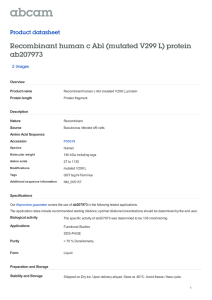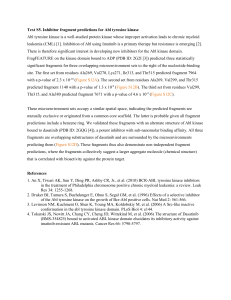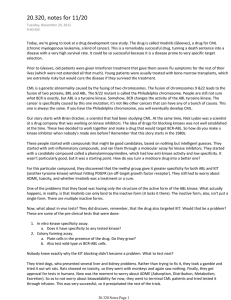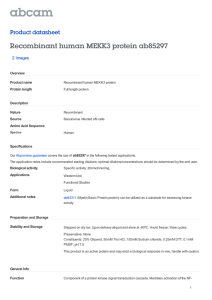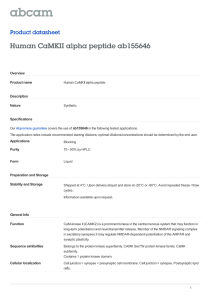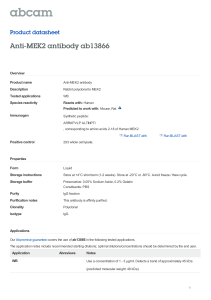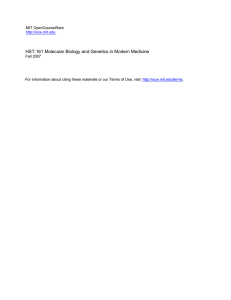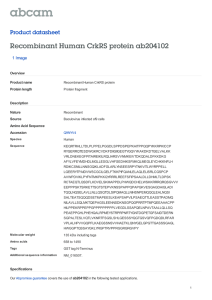Tyrosine Protein Kinase ABL1 Mira Patel H Molecular Human Anatomy
advertisement
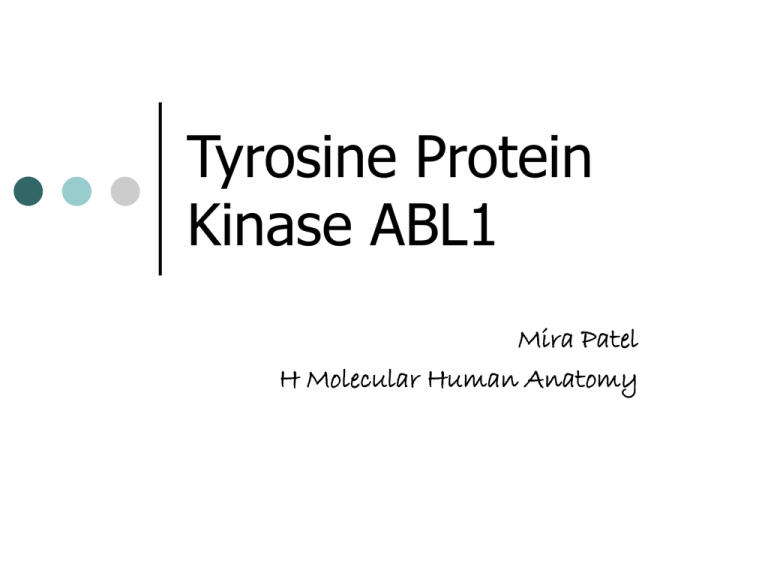
Tyrosine Protein Kinase ABL1 Mira Patel H Molecular Human Anatomy Kinases Attach a phosphate group to an amino acid residue of a protein Result is usually a conformational change that activates the substrate protein Activation allows proteins to take part in chemical reactions Over 500 different types of kinases Function is shared, so it can safely be assumed that structure will also be highly conserved c-abl Protein Named as a homolog of the v-abl oncogene, found in the Abelson murine leukemia virus Human c-abl tyrosine kinase is a product of the Abelson (abl) gene, located on the 9th chromosome Non-receptor tyrosine kinase Transfers a phosphate group from ATP to a tyrosine residue in a protein Located in both cell cytoplasm and the nucleus Functions are altered depending on its location in the cell protein is thought to move from one location to the other, depending on which of its functions are needed in the cell N lobe SH3 domain SH3-SH2 linker SH2-kinase linker Kinase Domain SH2 domain Myristoyl group C lobe ribbon view of abl tyrosine kinase (PDB 1opk X-RAY) Structure: N-terminal half N terminal cap ~80 amino acid residues Src Homology 2 (SH2) domain ~100 amino acid residues Src Homology 3 (SH3) domain ~50 amino acid residues Kinase domain encloses the ATP-binding site ATP Binding Pocket of Kinase Domain Kinase domain of c-abl (PDB 2v7a X-Ray) Phosphate Binding Loop Activation Loop Phosphate Binding Loop Activation Loop ribbon and surface views of hydrophobic ATP-binding cleft (PDB 1opk X-RAY) Structure: C-terminal half Binding elements for the SH3 domain Three nuclear localization signals Export signal DNA binding domain Actin-binding domain Cellular Function: Cytoplasm cytoskeleton remodeling actin binding domain suggests that c-abl can anchor actin filaments a similar domain is seen in proteins with cytoskeletal associations N terminus C terminus f-actin binding domain of c-abl (PBD 1zzp NMR) Cellular Function: Nucleus Cell is exposed to ionizing radiation c-abl phosphorylates p73 on Y99 Activation of p73 Induction of p21 gene p21 inhibits Cdk kinase activity Conclusion: c-abl can be involved in G1/S checkpoint, in a pathway independent of p53 ABL 1a and 1b Two variants of the abl protein—abl 1a and abl 1b Only difference is that form 1b has a posttranslational modification that form 1a lacks abl 1b is myristoylated For reasons that are not known, abl 1b is found in larger amounts in cells than abl 1a Abl and Src Kinases Many structural similarities between abl and src family kinases N-terminal half, minus the cap, is almost identical to an Src family kinase protein However, abl kinases differ in their C-terminal half, the domains of which are absent in Src family proteins Ribbon view of c-abl , c-src overlap N lobe SH3 domain Human tyrosine kinase c-abl (PDB 1opk X-RAY) Kinase Domain Human tyrosine kinase c-src (PDB 2src X-RAY) SH2-kinase linker SH3-SH2 linker SH2 domain Y527 C lobe http://jkweb.berkeley.edu/external/pdb/2003/hlabl/C0301076_Nagar_etal_fig2.jpg ClustalW between c-abl and c-src kinases (SH2, SH3, and kinase domains) _c-abl_ _c-src_ MGQQPGK-VLGDQRRPSLPALHFIKGAG----KKESSRHGGPHCNVFVEHEALQRPVASD MGSNKSKPKDASQRRRSLEPAENVHGAGGGAFPASQTPSKPASADGHRGPSAAFAPAAAE **.: .* ..*** ** . . ::*** ..: . .: . .* *.*:: _c-abl_ _c-src_ FEPQGLSEAARWNSKENLLAGPSENDPNLFVALYDFVASGDNTLSITKGEKLRVLGYNHN PKLFGGFNSSDTVTSP-QRAGPLAGGVTTFVALYDYESRTETDLSFKKGERLQIVNNTEG : * ::: :. *** .. . ******: : :. **:.***:*:::. ... _c-abl_ _c-src_ GEWCEAQTKNGQ-GWVPSNYITPVNSLEKHSWYHGPVSRNAAEYLLSSGIN--GSFLVRE DWWLAHSLSTGQTGYIPSNYVAPSDSIQAEEWYFGKITRRESERLLLNAENPRGTFLVRE . * . ..** *::****::* :*:: ..**.* ::*. :* ** .. * *:***** _c-abl_ _c-src_ SESSPGQRSISLRYEG-----RVYHYRINTASDGKLYVSSESRFNTLAELVHHHSTVADG SETTKGAYCLSVSDFDNAKGLNVKHYKIRKLDSGGFYITSRTQFNSLQQLVAYYSKHADG **:: * .:*: . .* **:*.. ..* :*::*.::**:* :** ::*. *** _c-abl_ _c-src_ LITTLHYPAPKRNKPTVYGVSPNYDKWEMERTDITMKHKLGGGQYGEVYEGVWKKYSLTV LCHRLTTVCP-TSKPQTQGLAK--DAWEIPRESLRLEVKLGQGCFGEVWMGTWNG-TTRV * * .* .** . *:: * **: * .: :: *** * :***: *.*: : * _c-abl_ _c-src_ AVKTLKEDTMEVEEFLKEAAVMKEIKHPNLVQLLGVCTREPPFYIITEFMTYGNLLDYLR AIKTLKPGTMSPEAFLQEAQVMKKLRHEKLVQLYAVVSEEP-IYIVTEYMSKGSLLDFLK *:**** .**. * **:** ***:::* :**** .* :.** :**:**:*: *.***:*: _c-abl_ _c-src_ ECNRQEVNAVVLLYMATQISSAMEYLEKKNFIHRDLAARNCLVGENHLVKVADFGLSRLM GETGKYLRLPQLVDMAAQIASGMAYVERMNYVHRDLRAANILVGENLVCKVADFGLARLI . : :. *: **:**:*.* *:*: *::**** * * ***** : *******:**: _c-abl_ _c-src_ TGDTYTAHAGAKFPIKWTAPESLAYNKFSIKSDVWAFGVLLWEIATYGMSPYPGIDLSQV EDNEYTARQGAKFPIKWTAPEAALYGRFTIKSDVWSFGILLTELTTKGRVPYPGMVNREV .: ***: ************: *.:*:******:**:** *::* * ****: :* _c-abl_ _c-src_ YELLEKDYRMERPEGCPEKVYELMRACWQWNPSDRPSFAEIHQAF LDQVERGYRMPCPPECPESLHDLMCQCWRKEPEERPTFEYLQAFL : :*:.*** * ***.:::** **: :*.:**:* :: : * sequence identity : strong conservation . weaker conservation 35.93% identity http://align.genome.jp/sit-bin/clustalw Regulation and Activity Pathways used to regulate abl activity are not clear Key structural differences between abl and src kinases lead to different regulatory mechanisms for the two proteins Activation of src kinase controlled by phosphotyrosine residue, Y527 This residue is absent in abl kinase Both kinases exist in an autoinhibited form Kinase domains are controlled negatively by other domains on the protein Mutations in or deletion of SH3 domain result in an active abl kinase that cannot otherwise be inactivated This suggests that the SH3 domain regulates the activity of the kinase domain in c-abl c-abl Proto-oncogene Translocation, t(9;22)(q34;q11), between abl (Abelson) and bcr (breakpoint cluster region) genes results in Philadelphia chromosome Fusion bcr/abl gene encodes altered kinase (bcr/abl kinase) that allows cell proliferation without regulation Philadelphia chromosome is directly responsible for chronic myeloid leukemia (CML), although individuals with acute myeloid leukemia (AML) or acute lymphoblastic leukemia (ALL) can also have this chromosome Chronic Myelogenous Leukemia Unnecessary and dangerous increase in the production of immature granulocytes Blood tissue becomes so packed with nonfunctional white blood cells that healthy blood cells can no longer be produced Leads to anemia, a dysfunctional immune system, and dangerous infections CML Treatment Kinase inhibitors designed bind to hydrophobic ATP-binding pocket of kinase ATP cleft is small and requires a small inhibitor molecule FDA approved kinase inhibitors to fight CML: Imatinib, marketed as Gleevec in 2001 by Novartis Pharmaceuticals Corporation Dasatinib, marketed as Sprycel in 2006 by Bristol-Myers Squibb Company Nilotinib, marketed as Tasigna in 2007 by Novartis Pharmaceuticals Corporation Patients diagnosed with CML must immediately begin taking kinase inhibitors in addition to chemotherapy treatment 1st generation inhibitor Gleevec Binds to only inactive conformations of bcr/abl Many mutation sites cause resistance A surface view of Gleevec in the hydrophobic ATP-binding pocket of the abl kinase domain (PDB 2hyy X-RAY) 2nd generation inhibitor Sprycel Binds to both active and inactive conformations of bcr/abl Overcomes many imatinib mutation sites A surface view of Sprycel in the hydrophobic ATP-binding pocket of the abl kinase domain (PDB 2gqg X-RAY) Gleevec: Mutation Sites Gleevec in the hydrophobic ATP-binding pocket of the abl kinase domain (PDB 1iep X-RAY) F317L Q252H/R Y253F/H E255K L387M T315I V379I M351T M244V Sprycel: Mutation Sites Sprycel in the hydrophobic ATP-binding pocket of the abl kinase domain (PDB 2gqg X-RAY) F317L T315I T315I GLEEVEC F317L SPRYCEL Activation Loop Phosphate Binding Loop Overlap of Gleevec and Sprycel in the hydrophobic ATP-binding pocket of the abl kinase domain (PDB 1iep X-RAY, 2gqg X-RAY) Drug Resistance • Mutation in T315, the “gatekeeper residue,” leads to resistance to Gleevec, Sprycel, and Tasigna • To combat this problem, another class of inhibitors must be used • SGX Pharmaceuticals is currently working with Novartis to produce a generation of abl-bcr kinase inhibitors that can overcome T315 mutation • Testing of this new drug, SGX393, is expected to be complete by June 2008, after which the developers may seek FDA approval for the drug T315I Mutation T315 I315 H Bonds GLEEVEC GLEEVEC SPRYCEL SPRYCEL (c-abl in complex with imatinib PDB 1iep X-RAY) (c-abl in complex with dasatinib PDB 2gqg X-RAY) (mutated c-abl kinase domain PDB 2v7a X-Ray) Conclusion Understanding structure of a protein can lead to structure-based drug designs, which have proven to be very effective Individuals afflicted with cancer are able to live normal and productive lives References Nagar, et al. Structural Basis for the Autoinhibition of c-Abl Tyrosine Kinase. http://www.sciencedirect.com/science?_ob=ArticleURL&_udi=B6WSN-486WNCND&_user=526750&_rdoc=1&_fmt=&_orig=search&_sort=d&view=c&_acct=C000023759& _version=1&_urlVersion=0&_userid=526750&md5=3c430835fc17373b68b770c1da093d1f Shaul, Y. c-Abl: activation and nuclear targets. http://www.nature.com/cdd/journal/v7/n1/full/4400626a.html Pendergast, Anne Marie. Nuclear tyrosine kinases: from Abl to WEE1. http://www.sciencedirect.com/science?_ob=ArticleURL&_udi=B6VRW-4547875C7&_user=6824479&_coverDate=04%2F30%2F1996&_rdoc=1&_fmt=summary&_orig=ar ticle&_cdi=6245&_sort=v&_docanchor=&view=c&_ct=29845&_acct=C000023759&_versio n=1&_urlVersion=0&_userid=6824479&md5=4feed9094a9b76b1ac3d8372c4e9c766 Hantschel, et al. Structural Basis for the Cytoskeletal Association of Bcr-Abl/c-Abl. http://www.cemm.oeaw.ac.at/downloads/MolecularCell19p461to473.pdf Shah, et al. Multiple BCR-ABL kinase domain mutations confer polyclonal resistance to the tyrosine kinase inhibitor imatinib (STI571) in chronic phase and blast crisis chronic myeloid leukemia. http://www.sciencedirect.com/science?_ob=ArticleURL&_udi=B6WWK-46KR83D7&_user=6824479&_origUdi=B6WWK-4D4KPHG4&_fmt=high&_coverDate=08%2F31%2F2002&_rdoc=1&_orig=article&_acct=C00002375 9&_version=1&_urlVersion=0&_userid=6824479&md5=72adfb4aa21d767908ef62e79d2ac 3ab Questions and/or Comments...
